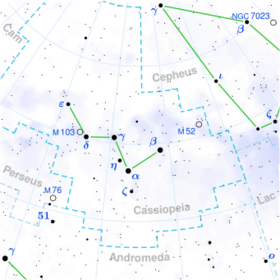Astronomy:6 Cassiopeiae
| Observation data Equinox J2000.0]] (ICRS) | |
|---|---|
| Constellation | Cassiopeia |
| Right ascension | 23h 48m 50.171s[1] |
| Declination | +62° 12′ 52.26″[1] |
| Apparent magnitude (V) | +5.43[2] (5.34 - 5.45[3]) |
| Characteristics | |
| U−B color index | −0.02[2] |
| B−V color index | +0.67[2] |
| Variable type | α Cyg[3] |
| Astrometry | |
| Proper motion (μ) | RA: −3.57±0.35[1] mas/yr Dec.: −1.57±0.33[1] mas/yr |
| Parallax (π) | 0.53 ± 0.37[1] mas |
| Distance | 2,510[4] pc |
| Absolute magnitude (MV) | −8.30[5] |
| Details | |
| Mass | 22.0[5] M☉ |
| Radius | 193[5] R☉ |
| Luminosity | 200,000[6] L☉ |
| Surface gravity (log g) | 1.59[7] cgs |
| Temperature | 10,023±227[7] K |
| Metallicity [Fe/H] | 0.29[7] dex |
| Rotational velocity (v sin i) | 50[5] km/s |
| Other designations | |
| Database references | |
| SIMBAD | data |
6 Cassiopeiae (6 Cas) is a white hypergiant in the constellation Cassiopeia, and a small-amplitude variable star.
System
6 Cassiopeiae A is a white A2.5 type hypergiant. It is about 25 times as massive as the Sun and 200,000 times as luminous. The star is slightly and erratically variable, an Alpha Cygni variable. Not all sources consider 6 Cas to be a hypergiant. It is thought that the "+" in an early A3 Ia+ spectral classification referred to indications of additional spectral features from a possible companion rather than the more modern indication of a hypergiant luminosity class. However, later publications have given more conventional hypergiant spectral types such as B9Ia+ and A3Ia+.[8]

6 Cas A has a number of close companions, most notably an 8th magnitude O class bright giant at only 1.5″. Its spectral type is O9.75 and its absolute magnitude is −5.8.[11] Both are considered to be members of the Cassiopeia OB5 stellar association at a distance of around 8,000 light-years,[12] along with several other nearby stars.[13] Gaia parallaxes of the nearby stars suggest a mean distance to the association of about 9,000 light years.[13]
Variability
6 Cas A is an α Cyg variable, pulsating erratically between 5.34 and 5.45. The strongest period detected in one study was 37 days.[9] It has the variable star designation V566 Cassiopeiae.[3]
References
- ↑ 1.0 1.1 1.2 1.3 1.4 van Leeuwen, F. (2007). "Validation of the new Hipparcos reduction". Astronomy and Astrophysics 474 (2): 653–664. doi:10.1051/0004-6361:20078357. Bibcode: 2007A&A...474..653V.Vizier catalog entry
- ↑ 2.0 2.1 2.2 Ducati, J. R. (2002). "VizieR Online Data Catalog: Catalogue of Stellar Photometry in Johnson's 11-color system". CDS/ADC Collection of Electronic Catalogues 2237: 0. Bibcode: 2002yCat.2237....0D.
- ↑ 3.0 3.1 3.2 Samus, N. N. et al. (2009). "VizieR Online Data Catalog: General Catalogue of Variable Stars (Samus+ 2007-2013)". VizieR On-line Data Catalog: B/GCVS. Originally Published in: 2009yCat....102025S 1: B/gcvs. Bibcode: 2009yCat....102025S.
- ↑ Mel'Nik, A. M.; Efremov, Yu. N. (1995). "A new list of OB associations in our galaxy". Astronomy Letters 21 (1): 10. Bibcode: 1995AstL...21...10M.
- ↑ 5.0 5.1 5.2 5.3 Verdugo, Eva; Talavera, Antonio; Gómez De Castro, Ana I.; Henrichs, Huib F. (2003). "Search for magnetic fields in A-type supergiants". A Massive Star Odyssey: From Main Sequence to Supernova 212: 255. Bibcode: 2003IAUS..212..255V.
- ↑ Achmad, L.; Lamers, H. J. G. L. M.; Pasquini, L. (1997). "Radiation driven wind models for A, F and G supergiants". Astronomy and Astrophysics 320: 196. Bibcode: 1997A&A...320..196A.
- ↑ 7.0 7.1 7.2 Prugniel, P.; Vauglin, I.; Koleva, M. (2011). "The atmospheric parameters and spectral interpolator for the MILES stars". Astronomy & Astrophysics 531: A165. doi:10.1051/0004-6361/201116769. Bibcode: 2011A&A...531A.165P.
- ↑ Skiff, B. A. (2014). "VizieR Online Data Catalog: Catalogue of Stellar Spectral Classifications (Skiff, 2009- )". VizieR On-line Data Catalog. Bibcode: 2014yCat....1.2023S.
- ↑ 9.0 9.1 Koen, Chris; Eyer, Laurent (2002). "New periodic variables from the Hipparcos epoch photometry". Monthly Notices of the Royal Astronomical Society 331 (1): 45–59. doi:10.1046/j.1365-8711.2002.05150.x. Bibcode: 2002MNRAS.331...45K.
- ↑ "Hipparcos Tools Interactive Data Access". ESA. https://www.cosmos.esa.int/web/hipparcos/interactive-data-access.
- ↑ Barsukova, E. A.; Chentsov, E. L. (1990). "The atmosphere of the supergiant 6 Cas. IV. The spectrum and radial velocities of the visual companion". Astrofiz. Issled. Izv. Spets. Astrofiz. Obs 29: 101. Bibcode: 1990AISAO..29..101B.
- ↑ Bartaya, R. A.; Chargeishvili, K. B.; Chentsov, E. L.; Shkhagosheva, Z. U. (1994). "Hypergiant 6 Cas and association Cas OB5". Bulletin of the Special Astrophysical Observatory 38: 103. Bibcode: 1994BSAO...38..103B.
- ↑ 13.0 13.1 Maíz Apellániz, J.; Barbá, R. H.; Fariña, C.; Sota, A.; Pantaleoni González, M.; Holgado, G.; Negueruela, I.; Simón-Díaz, S. (2021). "Lucky spectroscopy, an equivalent technique to lucky imaging". Astronomy & Astrophysics 646: A11. doi:10.1051/0004-6361/202039479.
External links
- 6 Cassiopeiae at Jim Kaler's Stars
 |


